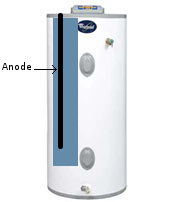Hot Water Heater Repair: Replacing the Anode
Author: steve Published Under: Home

In most peoples home, the water heater is still used to provide hot water for showering and cleaning. Hot water heaters are basically large tanks, which store water and have a heating element in them that keeps the water warm. When the hot water is turned on inside the house, cold water is sent into the hot water heater, to replenish it, which in turn causes the hot water heating element to turn on.
What Does an Anode Do?
While water heaters are mostly made out of steel today, if the inside of the tank were made of steel, then they would quickly become corroded. To help prevent this from occurring the inside of the tank, where the water is stored, is usually lined with a material like copper or a ceramic, which acts as a barrier preventing corrosion.
Despite having a layer of protection inside the tank, often there will be small holes in the layer, it could be too thin in certain areas, so to act as a sort of sacrificial lamb, manufacturers add an Anode.
The Anode is basically a long metal tube, usually made out of magnify or aluminum surrounding a steel stay rod, that is inserted into the tank and is designed to ensure that the corrosion occurs on the anode and not on the wall of the tank. The Anode starts out about .75 inches thick, but within a few years, it is no thicker than a pencil.
Installing a New Anode
Over time, it will be necessary to install a new anode, although it should be noted that some natural build up will also occur on the wall of the tank, acting as another barrier against corrosion.
Usually, the actual mechanics of removing the Anode is not to difficult and they usually can be removed using a hex head drive. However, problems can occur when there is not enough space above the water heater to physically remove the old anode or install the new one. This can be especially tricky in water heaters that are installed in crawlspaces or attics, although full length water heaters in a standard 8 foot high room, will also be difficult to install.
To get around this, it is often necessary to drain the water heater and tilt it onto its side, so that the anode can be inserted. There are also flexible anodes available, which can make this easier, but they do cost more as well.